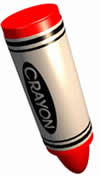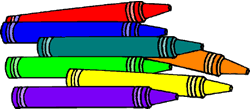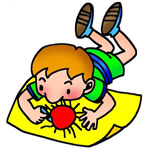Concepts

This lesson will demonstrate the making of Crayola products to introduce natural, capital, and human resources as well as touching on some other aspects in the Crayola industry such as producers and consumers.
Introduction
 The book How Is A Crayon Made will show students, through description and photo representation, how crayons are made in the factory. This background information will be reinforced and enhanced by the Internet links that are provided.
The book How Is A Crayon Made will show students, through description and photo representation, how crayons are made in the factory. This background information will be reinforced and enhanced by the Internet links that are provided.
The students will learn through the example of crayons that no matter what is being made, natural, human, and/or capital resources are required. While different resources sometimes need to be traced back to earlier steps or conditions than those in the actual production process, everything comes from something.
Learning Objectives
- List and classify resources into groups of capital, natural, and human resources.
- Gather/identify examples of capital, natural, and human resources from specified areas in the school.
- Sort and classify new examples of resources to demonstrate understanding.
Resource List
- How a Crayon Is Made by Oz Charles: A book available on amazon.
https://www.amazon.com/How-Is-Crayon-Made-Charles/dp/059045997X - How to Make Recycled Color Crayons: Simple, easy to follow directions to make new crayons.
familycrafts.about.com/cs/craftyrecipes/a/blhmcryons.htm  PBS: At this link the students can watch a video that shows how crayons are manufactured.
PBS: At this link the students can watch a video that shows how crayons are manufactured.
https://www.pbs.org/parents/rogers
- Artlex: At this link the students can find definitions of parafin and pigment.
http://artlex.com/ - Crayon Videos: These websites provide more videos showing how crayons are made:
https://science.howstuffworks.com/innovation/science-questions/question563.htm
https://makezine.com/2014/09/09/how-crayola-crayons-are-made/
- Extension Activity: For a further extension activity, see Samaritan’s Purse to learn about children around the world who are in need.
https://www.samaritanspurse.org/ - The Color of Resources: In this activity they will click and drag each of the pictures onto the box that shows whether it is a natural, capital, or human resource.
Activity - The Color of ResourcesWorksheet: In this activity students will draw lines from the pictures of resources to one of the three boxes to show whether the resource in question is a natural, capital or human resources.
www.econedlink.org/lessons/docs_lessons/711_worksheet5.pdf
Process
[NOTE: A previous lesson titled “Little Red Hen” does a nice job of establishing the criteria for identifying natural, human, and capital resources. You might find this helpful to look at this lesson as you prepare to provide definitions of those terms for your students. Another possibility would be to have your students complete the lesson “Little Red Hen” prior to their work on this lesson.]
Before they read How A Crayon Is Made, by Oz Charles, ask the students where they got their crayons, where the store (or their parents) got the crayons, etc. Next ask the students to think about what their crayons are made of, how they got to be all the same size, how they got into the boxes, etc. Make lists on the board or on chart paper to record the students’ answers.
With the students, read the story, How a Crayon Is Made, (If you do not have a copy of this book, the https://www.pbs.org/parents/rogers video on the PBS kids’ website will work just fine. This link will take you to the Mister Roger’s webpage.It provides many videos showing how different things are made. You then have to click on ‘Watch the Video.’ Here is a direct link to the “How to Make Crayons” video that is provided on the student page. [NOTE: You will need to have RealPlayer downloaded on the computer in order to play the video.] Have the students name the things they remember that were used to make crayons, and make a new list. If the students need prompting to identify people and machines involved in the process, ask them if the crayons made themselves. Go back through the book/video and add to the list.
OPTIONAL: Ask the students where specific ingredients- the pigment and, the parafin- came from. (You can look up definitions of these terms and provide them for younger students or you can have older students find definitions for themselves. It is easy to copy and paste from the artlex site. Use your own judgment.) Also ask where other important materials came from: the wood for the vats, the metal, etc.
Ask the students, working as a class, to divide up the list into three groups: things from nature, human participants, and things that were made and bought. (Remember, you are also trying to get the students to see at least part of the progression that took place before the manufacturing process began in the factory.) Once the students have formulated the three categories, remind then that each of these categories is a category of resources. Then rename the three groups as natural resources (things we get from nature), human resources (useful skills people have), and capital resources (things we use over and over to get or make things we want). Unless you have done the optional portion of this lesson, you may not have any natural resources on you list. If that is the case, you may choose to explain what has been involved in the process at an earlier stage.
Finally, read the directions and have the students complete either the printable worksheet or the interactive version of the activity to classify resources used to make crayons.
Conclusion
Tell the students that they have 30 seconds to go around the room and find/identify an example of a capital resource, a human resource, and a natural resource. This activity can be repeated in the cafeteria, outside, in the library, etc. Select several students to share what they have found for each category.
Extension Activity
1.Go to http://familycrafts.about.com/cs/craftyrecipes/a/blhmcryons.htm and follow the instructions to make homemade crayons. Review the different resources used to make the crayons.
- CAPITAL RESOURCES:
Old crayons
Flexible soap or candy molds (or you can use foil cupcake holders)
Heating device (microwave, or toaster oven) - NATURAL RESOURCE
(If it is a hot day outside you could place broken crayons in the molds and let the sun melt them. This would enable you to identify a direct natural resource, and you would not need the toaster oven.) - HUMAN RESOURCES:
Teacher
Student
Of course, the teacher would handle the wax and heating device, but the students could participate by peeling the paper from the old crayons, breaking them up, and sorting them by color. They also could try putting different colors together to see if they can create a new color.

EMPHASIZE THAT THIS ACTIVITY MUST BE DONE ONLY WITH AN ADULT PRESENT. WAX IS VERY FLAMMABLE.Introduce: Producers and Consumers
For a further extension activity, the students might package and sell sets of the crayons to the student body and use the money to buy school supplies for the needy. See (https://www.samaritanspurse.org/) to learn about children around the world who are in need.2. Record interesting facts that the children have learned about crayons along the way: How old are crayons? How many different colors of wrappers are there? What are the two favorite colors around the world?
3. Graph the favorite colors of students in the class using the colors from the 8 box. Which color won? Did any colors not get a vote?
4. Have the students color a picture with their homemade crayons- and you color one too!!!
Assessment
Restate and explain as necessary the definition of each kind of resource. Then have the students complete the activity below to demonstrate their understanding.
Have your students click here to complete the interactive activity. In this activity they will click and drag each of the pictures onto the box that shows whether it is a natural, capital, or human resource.
Have the students click here to complete the worksheet activity. In this activity they will draw lines from the pictures of resources to one of the three boxes to show whether the resource in question is a natural, capital or human resources. Click here to view the solutions for the worksheet.